The Indian subcontinent is home to one of the oldest civilizations in the world; since ancient times, its lands have been an attractive habitat for human life. Let’s dive into the ancient Indian civilization origins, its culture, and history.

Ancient Indian Civilization
Contents
Development
An ancient civilization that spanned from the 25th century BC to the 17th century BC was discovered in the 1920s. It was a civilization that had high urban development and two of its towns, Mohenjo-daro and Harappa, portray their highest level of development.
Life in India is shaped by geographical factors. In fact, the monsoon climate governs its life cycle so much that the transformation of nature is an aesthetic and religious determinant in its artwork. In spite of its geographic isolation, India has suffered from numerous Neolithic invasions, forming a great mosaic of cultures. The first aboriginal settlements date between 3000-2000 BC, during the Neolithic period. At around 1500 BC, Indo-European tribes start invading from the northwest, which destroyed the Indus Valley Civilization. Shortly thereafter – and up until 600 BC – the Vedic period sees the first great racial crossing between the natives and the Aryan invaders. At the end of this period the four sacred texts, or Vedas, emerge. In the Brahmanist period, between 600-300 BC, two great epics appear: the Mahabharata and the Ramayana.
The 2nd-1st centuries BC were dominated by the Sunga and Andhra dynasties, whom other invading peoples – the “Kushans” – join to dominate India until the 3rd century AD. In 320 AD, Chandragupta expels the Kushan invaders and establishes a new dynasty, forming the Gupta Empire. When it fell in 490 AD, a process moving towards Hinduism was initiated. At the same time, Brahmanism, which is based on ancestral cults, reappears, with its mythology summed up in the Mahabharata and the Ramayana. Following classical Gupta culture, the Post-Gupta period (6th-8th centuries AD) began and served as a transition towards the Hindu renaissance. Another parallel artistic development occurred alongside this final change: Indo-Islamic art.

In the 8th century AD, the first Arabian Umayyads arrive; two centuries later, Turkish-Islamic warriors invade India and establish independent sultanates in the north (14th-15th centuries AD). Mughal India, founded by Babur in 1526, was one of the richest cultures in the nation. Finally, European colonialism takes shape from 1600 AD, with British India and the establishment of commercial factories. At the beginning of the 20th century, the spiritual leader Mahatma Gandhi (1869-1948), begins the fight for independence, which is obtained on 15th August 1947.
Ancient Indian civilization developed in the area that now corresponds to Pakistan and western India. This territory is bordered to the north by the famous Himalayan mountain range (the highest on the planet), and in the south by the peninsula formed by the Deccan Plateau. In the center, there is a vast plain that is irrigated by the Indus, Ganges, and Brahmaputra rivers.
Social Organization
India was socially organized into castes, closed lifelong social classes that do not recognize social mobility. This caste social system was considered to be of divine origin and Hindu culture deemed it to be a revelation; this was developed more than 3,000 years ago.
Social pyramid
Brahmins: priests who were dedicated to interpreting the sacred scriptures and were at the top of the social pyramid. Brahmins were considered “earthly gods” and dealt exclusively with religious matters.
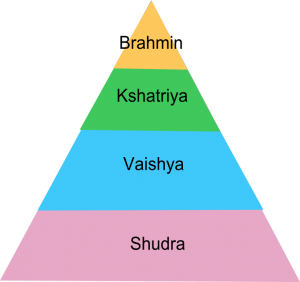
Kshatriyas: people who dedicated themselves to war. Some of them also held administrative positions in the state apparatus.
Vaishyas: farmers and traders.
Shudras: slaves, who had to be servants of the three higher castes, especially to the Brahmins.
Harijans: the descendants of the first Dravidians, and pariahs who had no caste or who had been expelled from their original castes for violating their ethical codes. For this reason, pariahs had to serve in the field or in domestic service.
Among the characteristics of the Indian caste system were strict and hereditary membership of the caste you were born in, the possibility to only marry people from the same caste, limitations in choice of work and personal contact with members of other castes, and each individual’s acceptance of the place that they had been assigned in society. The caste system has been perpetuated thanks to the concepts of reincarnation (samsara) and quality of action (dharma).
According to these religious beliefs, all people are reincarnated several times and have the possibility to be born in a higher caste provided that in their previous life they have obeyed the rules of the caste to which they belonged. In this way, the concept of dharma has always meant an aim to try in life to ascend to a higher caste, or transgress the caste system. In any social relationship, dharma can also be understood as a path or obligation, marking the path that runs through the lives of beings belonging to a caste in relation to those from another.
Economic Organization
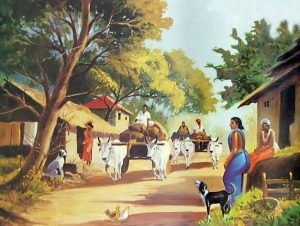
The economic history of India can generally be divided into four periods. The first one, which is called the pre-colonial period, covers up to the 17th century. The arrival of British colonization meant the beginning of the second period, which ended with independence in 1947. The third period spanned from 1947 to 1990, and the last, from 1991 to the present. In 1991 they started to liberalize the economy, and a new India was born.
The most important economic activity was agriculture, and they were also dedicated to cattle raising and the production of crafts with which they bartered. Later, they traded by inventing copper coins. Bills of exchange began to be used in India, which gave rise to banking in India.
The economic organization was based on agricultural activities. Rice production and irrigation canals were controlled by the government, but the diversity of India’s natural regions prompted planting other types of crops. The religions prohibited the consumption of meats, which is why the diet was exclusively vegetarian. The trading of cotton, weapons, metals, and precious stones meant great riches.
Agriculture: The main food crops were wheat and barley, which were sown in spring when flood waters receded and they grew with minimal effort. They also grew sesame, legumes, dates, and melons.
In some places, rice was also cultivated, but it only became a fundamental crop when their settlements extended to the Middle and Lower Ganges River after the 15th century BC.
Textiles: They used spinning mills and produced wool and cotton textiles.
Livestock: They bred a wide range of domestic animals, including donkeys, oxen, Indian humped cattle, river buffalo, elephants; animals that have since been considered to be typical parts of rural India’s landscape. They were unaware of horses.
Industry: They decorated their bodies with rich silver, gold, ivory, and precious stone ornaments. They knew of copper, tin, and lead. They used copper for weapons, instruments, and utensils. They also used bronze tools (including axes). For domestic purposes, they made various types of clay utensils. They mixed metallurgy and pottery with agriculture and livestock. They used animals for loading raw materials and goods for domestic consumption and trade, as well as for transport and plowing.
Trade: Most of the products they sold were luxurious: semi-precious stones, metals, seals, jewelry, various types of artistic objects, exotic animals, food products, clothing, and various manufactured goods. Products were always manufactured by the people, meaning that it was the elite, as said before, who controlled trade and benefited from the merchandise. Indus pottery also circulated throughout this area of South Asia: cups, crockery, and even flowerpots with inscriptions in Indian writing.
Political Organization
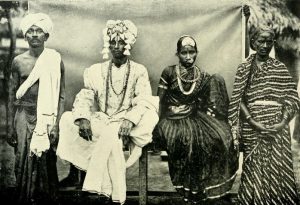
Everything revolved around a village chief who was chosen at times but mostly inherited the role. It was not until the period of the Aryan invasions that, in order to defend themselves, they needed to build city-states surrounded by walls and moats. At the center of these cities was the palace of the rajah, whose authority was considerably greater than that of the village chiefs.
The Dravidians, the first inhabitants of India, had dark skin and when the Aryan invaders ruled them, they formed empires that were always governed by an absolute monarch.
At the time of the Vedas (around 1400 BC), Indian society was divided into priests, warriors, farmers, and shepherds, but there were no slaves and there was normal social mobility in the societies of the period.
After the Aryan invasion, power resided with warriors for a time, but priests eventually managed to seize power and replaced the Vedic religion with Brahmanism and society was then divided into closed castes according to the Laws of Manu, which prohibited breeding between the castes. The ruling classes belonged to the Brahmin and Kshatriya castes and were led by a military chief. At first, monarchs were chosen, but later the title became hereditary.
Religion in Ancient India
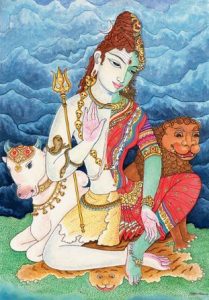
In the first centuries BC, religion was usually divided into Vedism, Brahmanism, and Buddhism. Vedism was the religion of the Aryan or Indo-Germanic peoples who settled during the second millennium BC; the gods were originally natural phenomena, then mythical figures. The rites were complex and required collaborations lasting several weeks between priests, poets, and exorcists. According to this doctrine, the soul survives the body. Sin is inherited and can be erased using magical practices.
The set of beliefs and institutions collected in the books Brahmanas and Upanishads by the priests of the time is known as Brahmanism. This religion arose in 1000 BC, recognizing Brahma, Vishnu and Shiva as the supreme gods who formed the trinity known as Trimurti. Brahmanism accepts as theory that man must purify itself, and if this requirement is not completed in life, man is reincarnated as another animal, man in a superior caste, a demon, or a god after death. Therefore, the believer must bypass this whirlwind and achieve final peace and rest.
Buddhism appeared in the 5th century BC with an Indian named Sakyamuni, who later became popular and had the nickname Buddha (the enlightened). He advocated perfect morals, based on charity, sweetness, and altruism, promising the righteous paradise or nirvana. Buddhism does not agree with sacrifices and condemns the caste regime.
Worldview
Most of the religions that originated in India (such as Hinduism and Buddhism) reveal a common worldview through their faith. For them, the cosmos is neither permanent nor created, and at its summit are the four kingdoms of rebirth, which are entirely mental and devoid of all form. Below, are the realms of the pure form, where the gods live. The same gods, subject to rebirth, should try to attain enlightenment. At the lowest level is the kingdom of desire, which consists of the heavens, in which the 33 Vedic gods of Hinduism, including Indra, or Sakka for Buddhists, live. On the same level live the humans, animals, and asuras (jealous gods). The hungry ghosts (pretas) and hells dwell below everything.
Scientific and technological development
Technological: They were notable for their early application of sanitary technologies and civil planning. The towns in the valley have some of the earliest examples of public baths, closed sewers, and communal granaries. The university at Takshashila was an important place of learning in the ancient world. It was the educational center of scholars from all over Asia, and many Greek, Persian, and Chinese students studied there.
Ancient India was also a leading player in maritime technology.
Indian architecture and construction techniques, called ‘Vaastu Shastra’, suggest a deep understanding of material engineering, hydrology, and sanitary services. Indian culture was also a pioneer in the use of vegetable dyes, such as indigo and cinnabar. Many of these dyes were used in paintings and sculptures. The use of perfumes demonstrates chemical knowledge, especially in the distillation and purification processes.
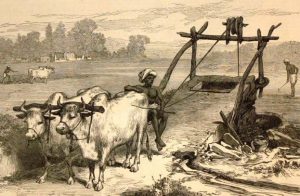
Scientific: During this period, India’s development in scientific matters was remarkable, especially in mathematics and astronomy, and for commercial and artistic affairs.
Astronomical references dealt with the Sun, the Moon, and the stars. Hindu astronomers resorted to the Greek theory of epicycles in order to explain complicated planetary movement, but instead of being round, theirs were elliptical.
The earliest evidence of mathematics is estimated to be from around the 8th-7th century BC, focusing on geometric applications for constructing religious buildings, and it also seems evident that they had used a system of positional and decimal numbering since ancient times. The main characteristic of mathematical development in this culture was the predominance of arithmetic rules of calculus, emphasizing the correct use of negative numbers and the introduction of zero, even going so far as to accept irrational numbers as valid numbers. They went into depth obtaining the rules of resolution of linear and quadratic equations, in which negative roots were interpreted as debts.
Mathematically, the Hindu origins of the decimal numbering system and the rules of calculus are considered undeniable.
Cities in Ancient India
The largest sites were the cities of Harappa and Mohenjo-daro. Their layout consisted of an elevated mound or citadel that dominated a more extensive residential area. The citadels appear to have contained buildings of a religious, ceremonial, and administrative nature, but there are no remains of any palaces. In some places, the layout of the city is evident, with traces of a regular network of crossing streets.
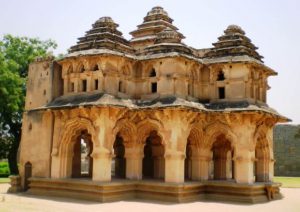
They used cooked bricks in construction. All cities were well-planned and built with baked bricks of the same size. The streets were drawn at right angles with an elaborate drainage system. There was a fairly clear division between localities and houses intended for the upper or lower classes of society.
There were also public buildings, the most famous of which are the Great Bath in Mohenjo-daro and large granaries. In addition, several metals such as copper, bronze, lead, and tin were produced, and some remnants of furnaces bear testimony to this fact. The discovery of brick kilns underpins the fact that baked bricks were widely used in the construction of domestic and public buildings.
From observation we can draw the following conclusions:
- There was general city planning.
- There was a difference in the importance of the streets (main and secondary streets), which ordered houses.
- Homes were a closed system, with houses existing together and overlooking an inner courtyard. Their relationship with the streets was practically non-existent, shielding private areas from the noise of the streets.
- They had a technical system for the production of constructive materials (for example bricks), which were made with what was provided by their surroundings.
- They had an infrastructure network; a sewage system and channeling to provide water.
Culture in Ancient India
These civilizations built smartly thought-out and well-planned cities. In addition to crops, they developed their own writing system, designed jewelry, and molded terracotta figures.
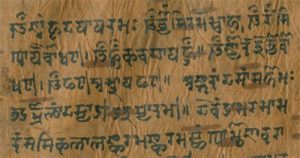 Writing: A system with characters and signs inscribed on cooked clay seals that still have not been deciphered by experts. It is known as the Indus script and refers to short groups of symbols written on slabs of clay or smooth stones.
Writing: A system with characters and signs inscribed on cooked clay seals that still have not been deciphered by experts. It is known as the Indus script and refers to short groups of symbols written on slabs of clay or smooth stones.
Statuettes and stamps: Terracotta figurines. These female figures were stylized and engorged goddesses of fertility. Necklaces and inlays of precious metals have been found in some of them.
Other handicrafts were also discovered, such as reproductions of miniature carts drawn by animals, as well as figures of animals in the region (rhinoceroses, tigers, monkeys, elephants, and buffalo). The tablets, which are believed to have been used as seals, were easily molded and heated in the oven to harden them. They were then coated with a type of varnish or lacquer, representing the animals mentioned above.
Traditions and present-day legacy
In India, there are many traditions that have been maintained since ancient times. Below, the most important are named:

The different cultural traditions can be seen in the innumerable forts, palaces, monuments, and tombs that are scattered around the Indian landscape, and the most significant are:
- The Taj Mahal.
- Qutb Minar.
- The Shore Temple.
- The Red Fort.
- Jama Masjid.
- Agra Fort.
- The Charminar.
- The Victoria Memorial.
- Buddhism, which expanded and has been preserved to this day.
Indian society continues to live according to the rigid caste system in which each person is grouped according to the work they perform in society. However, this classification has become more flexible today, as it is impossible to maintain in modern times where, for example, everyone is mixed on public transport. However, it is still maintained within families, in regards to exchanging food, choosing marriages, and the standing of the majority of Indian women in particular.
Ancient India: Conclusions
In conclusion, we can say that ancient India was a civilization that did not last long. It began in around the 25th century BC and ended in around the 17th century BC. Its short duration is due to invasions from other civilizations, or maybe due to some type of cataclysm that led to its demise.
Indian social structure followed the caste system, which organized the population into Brahmans, Kshatriyas, Vaishyas, and Shudras.
The economic organization was based on agricultural activities. Rice production and irrigation canals were controlled by the government, but the diversity of India’s natural regions prompted other types of crops. The religions prohibited the consumption of meats, which is why the diet was exclusively vegetarian. The trade of cotton, weapons, metals and precious stones meant great riches.
Hindu civilization evolved and in its beginnings, it imposed complicated cults and sacrifices. Nevertheless, Brahmanism was established into a unified religious element. Buddhism, preached by Sakyamuni, ended up being the wider received religion.
evertheless, Brahmanism was established into a unified religious element. Buddhism, preached by Sakyamuni, ended up being the wider received religion.
Political organization was influenced by religion. Religious religion had superiority over political power, which is why kings and princes were not sacred in nature. Every monarch had to act under the guidance of a priest.
The cultural legacy of Hindustani civilization is diverse, with architecture, monuments, palaces, temples, Sanskrit or the Hindu language, the invention of the numbers we use today (the value of the digit 0, not to forget decimals), yoga, and chess. However, its greatest contribution was Buddhism.
